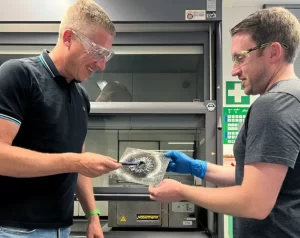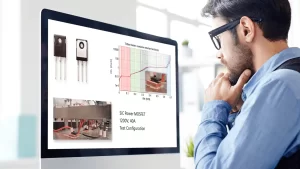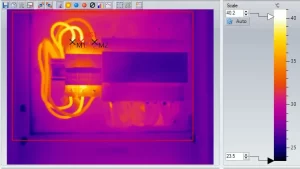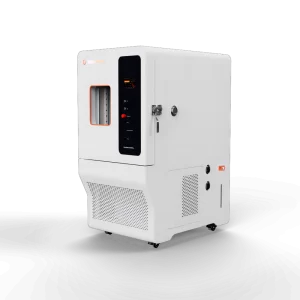What is Thermal Testing?
Thermal testing reveals how materials and devices respond to temperature changes. It involves exposing substances to different temperatures to assess their performance.
Accurate Thermal Testing
Accurate thermal testing goes beyond a quality check; it examines if products can handle challenges in their intended environments. It ensures reliability and longevity by addressing issues like extreme temperatures and effective heat dissipation.
Crucial in Diverse Industries
This testing is crucial in various industries, such as technology and healthcare. It enhances product reliability, meeting sector demands.
- In electronics, precise thermal testing prevents malfunctions from temperature changes. For batteries in devices or electric vehicles, this testing ensures safety and efficiency.
- The automotive industry, especially hybrid and electric vehicles, relies on thermal testing for components to handle diverse temperatures.
- Aerospace uses thermal testing to ensure materials endure extreme temperatures during space travel and re-entry.
- In the medical devices field, thermal testing ensures equipment functions reliably and safely in various medical environments.

Different Types of Thermal Testing
| Type of Thermal Testing | Description | Focus |
| Temperature Cycling Testing | Tests response to repeated temperature extremes. Simulates real-world conditions for durability. | Endurance under extreme temperature changes. |
| Thermal Shock Testing | Focuses on abrupt temperature changes. Determines material’s ability to endure sudden transitions. | Endurance in rapid temperature shifts. |
| Thermal Stress Screening | Exposes products to thermal cycling to identify defects. Helps uncover issues before reaching end-users. | Early detection of potential defects. |
| Heat Dissipation Testing | Evaluates how well a material or device releases heat. Crucial for preventing overheating in electronic components. | Heat release efficiency in preventing overheating. |
| Cooling Performance Testing | Assesses cooling mechanisms in products. Important for applications like computer systems and industrial equipment. | Efficiency of cooling mechanisms. |
| Thermal Mapping/Imaging Testing | Uses advanced technologies to visualize temperature distribution. Pinpoints areas of concern visually. | Visual identification of temperature patterns. |
| Environmental Testing | Broadens the scope to factors like humidity and atmospheric conditions. Ensures product resilience in intended environments. | Testing resilience to diverse environmental challenges. |
| Reliability Testing | Focuses on consistent performance over an extended period. Essential for longevity in critical applications. | Ensuring sustained and dependable performance. |
| Performance Testing | Measures a product’s operation under specific temperature conditions. Provides insights into overall functionality. | Assessing functionality and efficiency under defined temperatures. |
Tools Needed for Thermal Testing
To understand thermal testing, get to know the tools. They ensure precise and accurate temperature measurements, crucial for evaluating materials and devices. Each tool has a specific role in capturing and interpreting temperature changes.
Temperature Chambers
- Control temperatures precisely for testing.
- Simulate extreme conditions, ensuring thorough evaluations.
Thermal Couples/Probes
- Measure temperature directly for real-time data.
- Form the backbone of thermal analysis.
Heat Spreaders
- Manage thermal conductivity effectively.
- Disperse heat to minimize hotspots, ensuring uniform temperature distribution, especially in electronic components.
Liquid Baths
- Immerse specimens in controlled temperatures.
- Effective for assessing materials’ response to temperature changes in a submerged state.
Thermal Imagers
- Visualize temperature distribution with infrared technology.
- Identify patterns and anomalies, offering a holistic view of heat dispersion.
Thermocouples and Thermistors
- Specialized sensors for precise temperature measurement.
- Capture nuanced temperature changes, providing detailed insights into thermal behavior.
Infrared Thermography
- Capture infrared radiation for a comprehensive understanding of temperature variations.
- Go beyond the visible spectrum in temperature measurement.
How to Do Thermal Testing: Step By Step
To test temperature effectively, follow a systematic approach for accuracy. Each step is crucial in understanding how materials and devices behave thermally. Now, let’s explore the details of performing thermal testing, step by step.
Sample Preparation
- Understand the Material: Know the material or device; consider composition, use, and potential temperature changes.
- Choose Size and Shape: Pick a sample size and shape that matches real-world conditions for accurate testing.
- Prep the Surface: Ensure a clean and uniform sample surface for precise thermal readings.
Setup and Calibration
- Configure Temperature Chamber: Set up the temperature chamber to mimic expected conditions.
- Calibrate Instruments: Ensure accuracy by calibrating thermal couples, probes, and imagers.
- Verify Setup: Check components for proper functioning before starting the actual test.
Programming Test Parameters
- Define Parameters: Specify temperature ranges, exposure duration, and any cycling patterns.
- Determine Temperature Change Rate: Assess how quickly the material or device adapts to temperature fluctuations.
- Consider Environmental Factors: Account for humidity or atmospheric pressure if needed.
Collecting Thermal Data
- Real-Time Monitoring: Begin the thermal test, monitoring temperature changes in real-time.
- Record Data Periodically: Document thermal data at set intervals for analysis and validation.
- Note Anomalies: Record any unexpected thermal behavior to enhance understanding of material or device responses.

Best Practices in Thermal Testing
Successful thermal testing requires careful planning, attention to material details, and adherence to industry standards. Let’s explore the key practices that enhance the precision of thermal testing.
Test Planning and Protocol Development
- Define Scope Clearly: Clearly outline the thermal test’s objectives, expected outcomes, and potential challenges in the comprehensive test plan.
- Include Diverse Testing Parameters: Evaluate a wide range of temperatures, conditions, and stress scenarios for a thorough assessment.
- Calibration and Verification: Rigorously calibrate instruments before each session and verify testing accuracy before starting formal testing.
- Real-Time Documentation: Record key events, observations, and deviations from expected outcomes in real-time during the test process.
- Standardized Reporting: Develop a standardized reporting format to enhance communication and interpretation of thermal test results.
Considerations for Different Materials
- Metals and Alloys: Assess the thermal conductivity and be aware of phase transitions that may affect structural properties.
- Polymers and Plastics: Understand thermal expansion characteristics and evaluate the impact of temperature on material degradation.
- Electronic Components: Tailor testing protocols to assess heat dissipation strategies and identify critical temperature limits to prevent overheating.
Adhering to Industry Standards
- Familiarity with Standards: Understand industry-specific thermal testing standards relevant to the materials or devices being examined.
- Benchmarking: Use established standards as benchmarks to gauge the effectiveness and reliability of thermal testing.
- Compliance and Certification: Ensure thermal testing procedures align with regulatory requirements and seek certification to demonstrate adherence to industry norms.
- Updates in Standards: Stay vigilant for updates in industry standards, proactively incorporating any revisions into testing protocols for precision.
Thermal Testing in Product Development
In product development, thermal testing is crucial, shaping material and device reliability, performance, and lifecycle management.
Enhancing Product Reliability
- Early Weakness Identification: Thermal testing finds potential flaws early, allowing targeted improvements for better product reliability.
- Optimizing Material Selection: It helps choose materials that meet design needs and ensure long-term product reliability.
- Validating Design Assumptions: Confirms if the chosen design can handle thermal challenges for a reliable product.
Improving Performance and Efficiency
- Optimizing Cooling Systems: For products with cooling systems, thermal testing refines mechanisms for better performance.
- Preventing Overheating Issues: Helps set temperature limits, preventing performance issues in electronic components.
- Fine-Tuning Energy Efficiency: Adjusts energy consumption based on material responses, improving efficiency and supporting eco-friendly development.

Impact on Product Lifecycle Management
- Predictive Maintenance Strategies: Identifies issues early, extending product lifespan and reducing unexpected failures.
- Informed Lifecycle Planning: Guides decisions on upgrades, replacements, and retirements based on thermal data insights.
- Continuous Improvement Processes: Integrating thermal testing insights fosters a mindset for ongoing product development, ensuring adaptability to new technologies and environmental demands.
Environmental Factors in Thermal Testing
Understanding the impact of the environment is crucial in thermal testing. Factors like humidity, extreme conditions, and simulating real-world situations play a significant role.
Effect of Humidity on Test Results
Certain materials are sensitive to humidity changes, affecting thermal conductivity and expansion rates. Controlling humidity levels in thermal testing is vital for accurate results. For materials prone to corrosion, humidity is critical, and testing must address its potential impact on corrosion rates.
Testing under Extreme Conditions
Thermal testing under extreme conditions helps identify temperature thresholds where performance may degrade or fail. It serves as a stress test, revealing a product’s ability to withstand harsh environments. This is relevant for aerospace, automotive, or industrial applications. Testing under extreme conditions also aids in accelerated aging assessments for predictive maintenance strategies.
Simulating Real-world Environmental Scenarios
Thermal testing should simulate temperature variations and other environmental factors for a realistic representation. Dynamic testing environments, reflecting fluctuating temperatures and humidity, enhance result reliability. Tailoring testing scenarios to mimic specific environmental challenges a product might face ensures alignment with real-world conditions.
Economic Considerations in Thermal Testing
In product development strategy, the economic side of thermal testing is crucial. Balancing costs with the benefits of thorough thermal analysis is vital. Let’s explore the economic aspects, covering cost-benefit analysis, budgeting, and overall return on investment.
Cost-Benefit Analysis of Thermal Testing
Assess the financial, human, and time resources needed for thermal testing. Consider equipment costs, personnel training, and testing duration. Define tangible and intangible benefits, such as improved product reliability. Compare projected costs with expected benefits for informed decision-making.
Budgeting for Thermal Testing in Product Development
Integrate thermal testing into initial product development planning. Allocate a specific budget for thermal testing to treat it as an integral part of the process. Recognize variable costs based on product complexity, testing cycles, and precision levels. Include provisions for training personnel to enhance test accuracy.
Return on Investment in Thermal Testing
Connect insights from thermal testing to potential product enhancements. Emphasize long-term reliability gains and how testing extends product lifecycles. Showcase instances where thermal testing prevented costly post-production fixes, saving time and resources.
International Standards for Thermal Testing
International standards are crucial in thermal testing for accuracy and compatibility. Let’s explore key standards governing this area.
IEC 60068 – Environmental Testing Standard
IEC 60068 sets the benchmark for environmental testing, covering guidelines for thermal testing in different conditions.
- Temperature Variations: It outlines procedures for controlled temperature changes, evaluating thermal performance.
- Humidity Considerations: Addresses the impact of moisture on materials, crucial for assessing product resilience.
ASTM E1530 – Calibration of Liquid-in-Glass Thermometers
This standard focuses on precise temperature measurement through the calibration of these thermometers, essential for accurate testing.
- Calibration Procedures: Provides detailed steps for verifying thermometer accuracy in thermal tests.
- Traceability and Reproducibility: Emphasizes reliable temperature measurements, contributing to testing precision.
ASTM E641 – Contamination Outgassing in Vacuum Systems
This standard concentrates on preventing contamination outgassing in vacuum environments, vital for materials’ performance.
- Quantifying Outgassing: Outlines methods to measure material outgassing levels, crucial for suitability in vacuum systems.
- Materials Testing: Offers a framework for testing materials in vacuum conditions, essential for space or semiconductor applications.
Thermal Testing and Product Liability
Thermal testing demonstrates due diligence in product development, showcasing a commitment to safety. Rigorous testing acts proactively to minimize the risk of product liability claims. In legal defense, documented thermal testing processes and results become crucial evidence of comprehensive safety and performance validation.
Legal Implications of Failed Thermal Testing
A failure in thermal testing can lead to allegations of a breach of duty, holding manufacturers accountable for negligence. Failed testing may contribute to claims of product defects, assessing whether thermal issues directly caused harm. Legal implications may extend to compensating consumers for losses due to product malfunction.
Future Trends in Thermal Testing
The future of thermal testing will bring major technological advancements that will reshape the field. Let’s explore upcoming trends:
Advancements in Technology
AI and Machine Learning
- Data Pattern Recognition: AI and machine learning will revolutionize thermal testing by identifying detailed thermal behaviors to improve test accuracy.
- Predictive Analysis: AI integration enables predicting potential thermal issues based on historical data, preventing product failures.
- Automated Decision-Making: AI systems speed up testing and make real-time adjustments for efficiency.
Integration with Industry 4.0
- Connected Ecosystems: Industry 4.0 principles will link thermal testing, allowing real-time monitoring and control.
- Automated Workflows: Smart factories will streamline testing processes, reducing manual work.
- Digital Twin Integration: Digital twins will create accurate virtual representations for better simulations.
Predictions for the Next Decade
- Enhanced Sensors: Sensors will become more sensitive, detecting subtler temperature changes for a better understanding of materials and devices.
- Quantum Sensor Usage: Extremely precise quantum sensors will be widely used, setting new standards for temperature measurement accuracy.
- Customized Solutions: Tailored thermal testing solutions will rise, matching specific industry needs more precisely.
Key Takeaways
- Thermal testing is crucial across industries, enhancing product reliability, performance, and compliance.
- Methods include temperature cycling, thermal shock, stress screening, and heat dissipation testing.
- Precision relies on tools like temperature chambers, thermal couples, and infrared thermography.
- Strategic planning involves comprehensive test plans, industry standards adherence, and integration into product development.
- Considerations include understanding humidity effects, testing under extreme conditions, and simulating real-world scenarios.
- Economic evaluation involves cost-benefit analysis and assessing return on investment.
- Regulatory compliance is essential for aligning thermal testing with industry standards.
- Legal ramifications highlight the importance of rigorous testing for both technical and legal safeguarding.
- Technological advancements include evolving sensor technologies, miniaturization, AI integration, and quantum sensors.
- A strategic roadmap integrates testing into business strategies for long-term sustainability.
- Future trends anticipate AI, machine learning, Industry 4.0, and widespread quantum sensor adoption shaping thermal testing.
Effective thermal testing is vital for product reliability, performance, and compliance. We encourage organizations to embrace insights from this guide and implement robust thermal testing practices. It not only enhances product quality but also positions businesses as industry pioneers.



